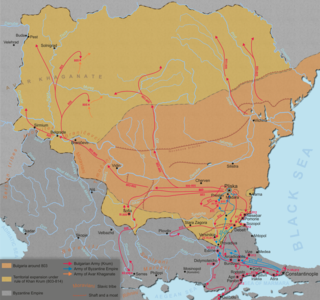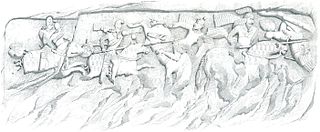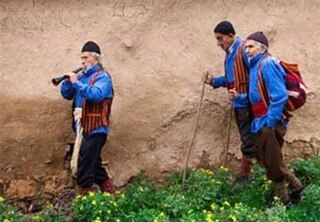This article includes a list of references, related reading, or external links, but its sources remain unclear because it lacks inline citations .(November 2022) |
The Tabarian calendar is the indigenous solar calendar of the Mazandaranis and Gilaks.
This article includes a list of references, related reading, or external links, but its sources remain unclear because it lacks inline citations .(November 2022) |
The Tabarian calendar is the indigenous solar calendar of the Mazandaranis and Gilaks.
| Tabarian months | Equivalent in Solar hijri | Equivalent in Gregorian |
|---|---|---|
| 1.Fardine Ma | 2 Mordad - 31 Mordad | 24 July - 22 August |
| 2.Kerche Ma | 1 Shahrivar - 30 Shahrivar | 23 August - 21 September |
| 3.Hare Ma | 31 Shahrivar - 29 Mehr | 22 September - 21 October |
| 4.Tire Ma | 30 Mehr - 29 Aban | 22 October - 20 November |
| 5.Melare Ma | 30 Aban - 29 Azar | 21 November - 20 December |
| 6.Shervine Ma | 30 Azar - 29 Dey | 21 December - 19 January |
| 7.Mire Ma | 30 Dey - 29 Bahman | 20 January - 18 February |
| 8.Une Ma | 30 Bahman - 29 Esfand | 19 February - 20 March |
| Shishek Pitek | 30 Esfand - 5 Farvardin | 21 March - 25 March |
| 9.Arke Ma | 6 Farvardin - 4 Ordibehesht | 26 March - 24 April |
| 10.De Ma | 5 Ordibehesht - 3 Khordad | 25 April - 24 May |
| 11.Vahmane Ma | 4 Khordad - 2 Tir | 25 May - 23 June |
| 12.Nurze Ma | 3 Tir - 1 Mordad | 24 June - 23 July |

Ezekiel or Ezechiel is the central protagonist of the Book of Ezekiel in the Hebrew Bible.

Year 803 (DCCCIII) was a common year starting on Sunday of the Julian calendar.

Year 633 (DCXXXIII) was a common year starting on Friday of the Julian calendar. The denomination 633 for this year has been used since the early medieval period, when the Anno Domini calendar era became the prevalent method in Europe for naming years.

Year 224 (CCXXIV) was a leap year starting on Thursday of the Julian calendar. At the time, it was known as the Year of the Consulship of Iulianus and Crispinus. The denomination 224 for this year has been used since the early medieval period, when the Anno Domini calendar era became the prevalent method in Europe for naming years.
A solar calendar is a calendar whose dates indicate the season or almost equivalently the apparent position of the Sun relative to the stars. The Gregorian calendar, widely accepted as a standard in the world, is an example of a solar calendar. The main other types of calendar are lunar calendar and lunisolar calendar, whose months correspond to cycles of Moon phases. The months of the Gregorian calendar do not correspond to cycles of the Moon phase.
The Iranian calendars or Iranian chronology are a succession of calendars created and used for over two millennia in Iran, also known as Persia. One of the longest chronological records in human history, the Iranian calendar has been modified time and again during its history to suit administrative, climatic, and religious purposes. The most influential person in laying the frameworks for the calendar and its precision was the 11th century Persian polymath, hakim Omar Khayyam. The modern Iranian calendar is currently the official civil calendar in Iran and Afghanistan.

Mazandaran province is one of the 31 provinces of Iran, located along the southern coast of the Caspian Sea and in the adjacent Central Alborz mountain range, in central-northern part of the country. The province covers an area of 23,842 km2. It was founded in 1937.
Abū Jaʿfar Muḥammad ibn Jarīr ibn Yazīd al-Ṭabarī, more commonly known as al-Ṭabarī (الطبري), was a Muslim historian and scholar from Amol, Tabaristan. Among the most prominent figures of the Islamic Golden Age, al-Tabari is known for his historical works and his expertise in Qur'anic exegesis, but he has also been described as "an impressively prolific polymath". He wrote works on a diverse range of subjects, including world history, poetry, lexicography, grammar, ethics, mathematics, and medicine.

Jāmiʿ al-bayān ʿan taʾwīl āy al-Qurʾān, popularly Tafsīr al-Ṭabarī, is a Sunni tafsir by the Persian scholar Muhammad ibn Jarir al-Tabari (838–923). It immediately won high regard and has retained its importance for scholars to the present day. It is the earliest major running commentary of the Quran to have survived in its original form. Like his history, al-Tabari's tafsir is notable for its comprehensiveness and citation of multiple, often conflicting sources. The book was translated into Persian by a group of scholars from Transoxania on commission of the Samanid king, Mansur I (961–976).

Mazandarani (مازندرانی), or Tabari (طبری), is an Iranian language of the Northwestern branch spoken by the Mazandarani people. As of 2019, there were 2 million native speakers. As a member of the Northwestern branch, etymologically speaking, it is rather closely related to Gilaki and also related to Persian, which belongs to the Southwestern branch. Though the Persian language has influenced Mazandarani to a great extent, Mazandarani still survives as an independent language with a northwestern Iranian origin.
The Armenian calendar is the calendar traditionally used in Armenia, primarily during the medieval ages.
Nima is a Persian male given name popular in Iran. It is also a popular female given name in India meaning "moon" and is derivative of the Sanskrit given name "Purnima", meaning "full" (pur) + "moon" (nima).

The Tabarian New Year, or Neowrez, occurs in the pintek days of the Tabarian Calendar.

Muhammad's first revelation was an event described in Islamic tradition as taking place in 610 CE, during which the Islamic prophet Muhammad was visited by the angel Jibrīl (Gabriel), who revealed to him the beginnings of what would later become the Qur'an. The event took place in a cave called Hira, located on the mountain Jabal an-Nour near Mecca.
The Rumi calendar, a specific calendar based on the Julian calendar, was officially used by the Ottoman Empire after Tanzimat (1839) and by its successor, the Republic of Turkey until 1926. It was adopted for civic matters and is a solar based calendar, assigning a date to each solar day.
The expedition of Dhat al-Riqa took place in July AD 625, or after the Battle of Khaybar in AD 628, i.e. AH 7 of the Islamic calendar. Two Quran verses, 5:11 and 4:101, are related to this event.
Tabrian or Tabariyan or Tabryan may refer to:
Sind was an administrative division of the Umayyad Caliphate and later of the Abbasid Caliphate in post-classical India, from around 711 CE with the Umayyad conquest of Sindh by the Arab military commander Muhammad ibn al-Qasim, to around 854 CE with the emergence of the independent dynasties of the Habbarid Emirate and the Emirate of Multan. The "Governor of Sind" was an official who administered the caliphal province over what is now Sindh, Pakistan.
Abdallāh ibn Aḥmad ibn Muḥammad, better known as Ibn al-Mughallis, was a medieval Arab Muslim theologian and jurist.
Mazandarani culture includes existing social characteristics and norms as well as beliefs, arts, laws, customs and traditions that are common among the Mazandarani people.